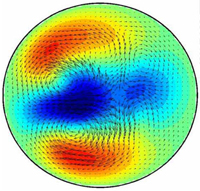Boundary layer transition by discrete and continuous modes
Duration: 21 mins 46 secs
Share this media item:
Embed this media item:
Embed this media item:
About this item

| Description: |
Durbin, R (Iowa State)
Wednesday 10 September 2008, 11:30-11:50 |
|---|
| Created: | 2008-10-06 16:08 | ||||
|---|---|---|---|---|---|
| Collection: | The Nature of High Reynolds Number Turbulence | ||||
| Publisher: | Isaac Newton Institute | ||||
| Copyright: | Durbin, R | ||||
| Language: | eng (English) | ||||
| Keywords: | Transition; Turbulence; | ||||
| Credits: |
|
||||
| Abstract: | The natural and bypass routes to boundary layer turbulence have traditionally been studied independently. One can characterize our study as an exploration of the situation in which both occur. Experiments indicate that this may be pertinent in certain flow regimes, particularly in adverse pressure gradients. We study this case by direct numerical simulation (DNS). The inflow condition is a superposition of a 3-D continuous mode and a 2-D T-S wave onto a Blasius mean flow. The T-S and continuous modes are obtained by solving the Orr-Sommerfeld and Squire equations by well established numerical methods. The DNS is accomplished with a finite volume, staggered mesh, fractional step algorithm for incompressible Navier-Stokes equations. Either mode, of itself, is unable to provoke transition. With both modes present, transition usually occurred within the computational domain. Transition was preceded by the appearance of Lambda-shaped velocity contours. Although this is reminiscent of secondary instability of T-S waves, the lateral spacing between Lambda's was very much narrower and seemed to be controlled by spanwise wavelength in the continuous mode. However, the spacing and wavelength were not necessarily equal. Two broad classes of behavior were seen, as epitomized by modes 2 and 5. In mode 2 the Lambda's were grouped in staggered rows. The elements of a row are pairs Lambda's. The pairs are aligned in $z$ within the row, which is followed by another row of pairs, shifted horizontally half way between the previous row. Flow visualization will be presented. The lateral spacing between Lambda's within a row is equal to that of the continuous mode --- actually of the perturbation jets spawned by the continuous mode. Mode 5 produced a more irregular pattern, but still arranged in pairs Lambda's. Unlike mode 2, their spanwise spacing differs from that of the continuous mode; it appears to be about three times as wide. Another curious aspect of mode 5 is that a larger streak amplitude can delay transition. Mode 2 shows transition to move upstream as the Klebanoff streaks get stronger. Mode 5 initially promotes transition, then, as its amplitude increases further, it delays transition.
A seminar from the Wall Bounded Shear Flows: Transition and Turbulence conference in association with the Newton Institute programme: The Nature of High Reynolds Number Turbulence www.newton.ac.uk/programmes/HRT/seminars/ |
|---|---|
Available Formats
| Format | Quality | Bitrate | Size | |||
|---|---|---|---|---|---|---|
| MPEG-4 Video | 480x360 | 1.83 Mbits/sec | 299.19 MB | View | Download | |
| WebM | 450x360 | 596.89 kbits/sec | 94.58 MB | View | Download | |
| Flash Video | 480x360 | 798.67 kbits/sec | 127.91 MB | View | Download | |
| iPod Video | 480x360 | 502.12 kbits/sec | 80.42 MB | View | Download | |
| QuickTime | 384x288 | 842.15 kbits/sec | 134.88 MB | View | Download | |
| MP3 | 44100 Hz | 125.0 kbits/sec | 19.67 MB | Listen | Download | |
| Windows Media Video | 474.15 kbits/sec | 75.94 MB | View | Download | ||
| Auto * | (Allows browser to choose a format it supports) | |||||

